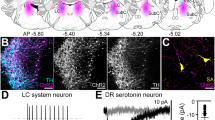Abstract
THE identification of either L-glutamate or L-aspartate as excitatory transmitters in the mammalian central nervous system would be facilitated by the discovery of specific antagonists of amino acid-induced and synaptic excitation. Hall et al. have suggested that D-α-aminoadipate may be an amino acid antagonist1. They based their suggestion on the depressant effect of the DL form on spontaneous and amino acid-induced excitation of rat thalamic neurones, the L form being weakly excitatory. We have shown that related long-chain amino acids depress synaptic excitation of spinal neurones and exert a differential depressant action on chemically induced excitation of these cells2. We therefore tested the actions of both D- and DL-α-aminoadipate on synaptically evoked excitation and on excitations induced by acetylcholine, L-glutamate, L-aspartate, kainate and N-methyl-D-asparate (NMDA) on spinal neurones. These latter two amino acids have been suggested to act on ‘glutamate-preferring’ and ‘aspartate-preferring’ receptors, respectively3,4. The results presented here indicate that D-α-aminoadipate selectively antagonises NMDA- and L-aspartate-induced responses of dorsal horn interneurones and Renshaw cells and depresses non-cholinergic synaptic excitation of these cells evoked by dorsal root stimulation, whereas cholinergic excitation of Renshaw cells evoked by iontophoretic acetylcholine or ventral root stimulation is not depressed by this agent.
This is a preview of subscription content, access via your institution
Access options
Subscribe to this journal
Receive 51 print issues and online access
$199.00 per year
only $3.90 per issue
Buy this article
- Purchase on Springer Link
- Instant access to full article PDF
Prices may be subject to local taxes which are calculated during checkout
Similar content being viewed by others
References
Hall, J. G., McLennan, H. & Wheal, H. V. J. Physiol., Lond. 272, 52–53P (1977).
Biscoe, T. J. et al. Eur. J. Pharmac. 45, 315–316 (1977).
Johnston, G. A. R., Curtis, D. R., Davies, J. & McCulloch, R. M. Nature 248, 804–805 (1974).
McCulloch, R. M., Johnston, G. A. R., Game, C. J. A. & Curtis, D. R. Expl Brain Res. 21, 515–518 (1974).
Biscoe, T. J., Headley, P. M., Martin, M. R. & Sterling, C. A. J. neurol. Sci. 31, 51–61 (1977).
Davies, J. & Watkins, J. C. Brain Res. 130, 364–368 (1977).
Curtis, D. R. & Ryall, R. W. Expl Brain Res. 2, 81–96 (1966).
Davidoff, R. A., Graham, L. T., Shank, R. P., Werman, R. & Aprison, M. H. J. Neurochem. 14, 1025–1031 (1967).
Duggan, A. W. Expl Brain Res. 19, 522–528 (1974).
Author information
Authors and Affiliations
Rights and permissions
About this article
Cite this article
BISCOE, T., EVANS, R., FRANCIS, A. et al. D-α-Aminoadipate as a selective antagonist of amino acid-induced and synaptic excitation of mammalian spinal neurones. Nature 270, 743–745 (1977). https://doi.org/10.1038/270743a0
Received:
Accepted:
Published:
Issue Date:
DOI: https://doi.org/10.1038/270743a0
This article is cited by
-
The 1980s: d-AP5, LTP and a Decade of NMDA Receptor Discoveries
Neurochemical Research (2019)
-
The glutamate story
British Journal of Pharmacology (2006)
-
Electrogenic Glutamate Transporters in the CNS: Molecular Mechanism, Pre-steady-state Kinetics, and their Impact on Synaptic Signaling
The Journal of Membrane Biology (2005)
-
Pathways of the past: the imprint of memory
Nature Reviews Neuroscience (2004)
-
Rapid increase of intracellular Ca2+ concentration caused by aminoadipic acid enantiomers in retinal M�ller cells and neurons in vitro
Documenta Ophthalmologica (1992)
Comments
By submitting a comment you agree to abide by our Terms and Community Guidelines. If you find something abusive or that does not comply with our terms or guidelines please flag it as inappropriate.



